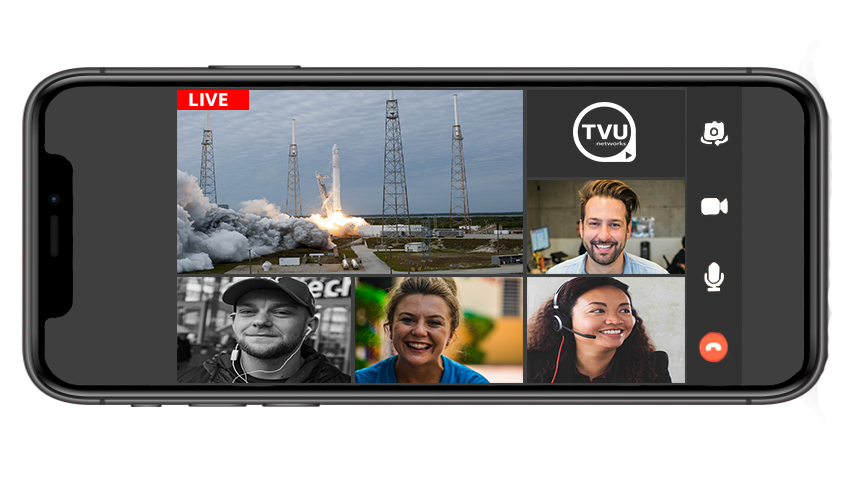TVU Partyline Offers Producers, Talent Solution for Remote Production
TVU founder and CEO Paul Shen discusses how the product bridges today’s remote production gap

Late last month, TVU Networks announced Partyline, a communications tool designed specifically to make life a bit easier for production crews grappling with the challenges of show production during COVID-19 pandemic lockdowns.
Think of a mashed up intercom and IFB system together with HD video of all Partyline participants, such as producers, talent and guests, and you get an idea of what Partyline can do.
Leveraging the cloud and the company’s Real-Time Interactive Layer (RTIL), part of TVU’s Inverse Stat-Mux technology, to transport virtual intercom/IFB-related audio and video bits, Partyline enables common communications among all participants as well as directed communications to specific individuals regardless of their location.
Supporting a variety of professional features, including mix-minus audio, undetectable video and audio delay and synced AV signals, Partyline is available to users of TVU Producer, TVU Anywhere and TVU One.
Late last week, Paul Shen, founder and CEO of TVU Networks, took out a few minutes to talk about the origin of Partyline, what makes it different from consumer solutions like Zoom meetings and the future of remote production.
(An edited transcript.)
TVTechnology: Was Partyline in the works prior to the COVID-19 outbreak, or did you suddenly see your customers needing this communications capability? In other words, what came first, the virus or the Partyline?
Get the TV Tech Newsletter
The professional video industry's #1 source for news, trends and product and tech information. Sign up below.
Paul Shen: The virus.

TVT: So you hustled to get Partyline out.
PS: Yes. This organization’s [TVU Networks] entire development philosophy is based on what we call “Dev Ops.”
Our products are usually released on databases. What that means is internally we are not thinking of a product, we are thinking of microservices.
So when this [COVID-19] surfaces, we said: “OK, people are removed from working with each other. They no longer have the real-time interactivity among them and also with their equipment. That’s missing throughout the whole remote working process.”
So, there were two components that must be addressed. One is quality and the other is interactivity—and how we can put them together. We said, “Let’s create a real-time interactive way to do that.”
TVT: At the very beginning of the lockdowns and work-from-home mandates, broadcasters began using tools like Zoom and Slack. But Partyline is purpose-built for broadcasters and the production community. Given the short development cycle for Partyline is it fair to say your engineers drew on TVU’s experience with customers rather than lengthy research to guide them through the process?
PS: Precisely. In fact, this project was quite amazing. Partyline is available across TVU Anywhere, TVU Producer as well as our physical transceiver, our TVU One. It spreads across the entire portfolio. It’s another microservice that spreads across all of them.
One of the very important differences between Partyline and consumer products, such as Zoom, is mix-minus. This is a huge issue that Zoom cannot deal with.
Another big part of the problem is people being interviewed, they don’t just want to watch the host, they want to watch the program.
The same is true of the whole production crew. They want to be a part of it, but they want to talk to the right people—they don’t want to just broadcast to everyone.
Video conferencing really cannot handle these issues.
TVT: The Real-Time Interactive Layer (RTIL) that’s part of the TVU Inverse Stat-Mux technology serves to transport the audio and video of participants in a Partyline session. Does this in any way degrade contribution video quality?
PS: No. In fact, that is a very important part of what we’ve done. That is to make sure that there is a very clear priority separation between the bits transported via RTIL and the bits used to contribute video for the broadcast side. Broadcast bits are given the highest priority.
TVT: Even though the work-from-home orders are in place, many broadcasters are relying on skeleton crews on premise to carry on operations. This makes me wonder if there is the ability to integrate Partyline with existing professional intercom systems so production personnel on site can have this communication link with those working remotely.
PS: It integrates with existing intercom systems. It has an intercom interface. So, the intercom user can talk directly into it. That’s something that people inside of our industry think about, but it’s not really something that people from the computer industry would think about.
TVT: When COVID-19 finally passes, do you think production will return to normal, or do you think it will have a lasting effect and there will be a continuation of these remote workflows?
PS: As the producer of this product, we always said that remote production is where the future is. The main reason is the cost difference is so significant.
The whole coronavirus outbreak accelerated remote production because people are forced into this situation. But once people experience this, I don’t think they will return [to conventional ways].
The whole economy has caught a cold right now. In the next two quarters, we will see the effects. So during this period, people want to save costs. Moving forward, people will want to make production much more efficient so they can create much more product at a much lower cost.
The industry is moving in that direction. Young viewers want to watch much more content than the mainstream media can deliver because the production costs of the mainstream media are way too high. But with this, the production costs can be significantly less.
More information is available on the TVU Networks website.
Phil Kurz is a contributing editor to TV Tech. He has written about TV and video technology for more than 30 years and served as editor of three leading industry magazines. He earned a Bachelor of Journalism and a Master’s Degree in Journalism from the University of Missouri-Columbia School of Journalism.

